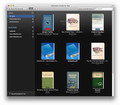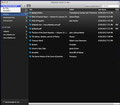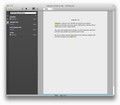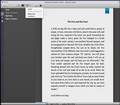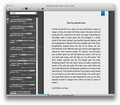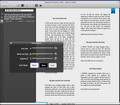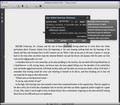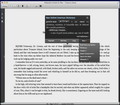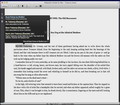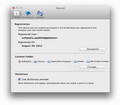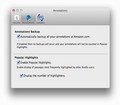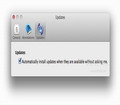Thanks to Amazon’s Whispersync technology, you can read the same e-book on multiple devices, without worrying about details such as bookmarks or the furthest page read. Kindle for Mac allows you to continue your reading on your desktop computer without missing a beat.
With all the Kindle reading applications for different platforms provided by Amazon, purchasing an actual Kindle device is not a necessity anymore. Kindle for Mac follows the same line: just make sure you know your Amazon account’s credentials and you can read away in a matter of minutes.
Kindle for Mac will automatically detect all the titles included in your library and a double click on the e-book's cover will quickly download it to your computer. Managing your Library’s content is rather intuitive, but the real fun begins when you discover the reading area: full screen support, 3 color modes (black, white and sepia), and, among others, text and brightness controls.
Kindle for Mac does not deliver very complex features and, if you are familiar with the portable device, there are no surprises for you. On the other hand, the app comes with the Mac OS X look and feel and an “easy on the eyes” design that differentiates it from other e-book readers.
The Looks
Kindle for Mac is styling a simple, somber and very efficient interface: the main window is displaying your Library’s categories on the left and the content of each subdivision on the right. Initially, your e-books are grouped into downloaded and archived items, and, if you use an Amazon account, you may also arrange them by collections (a drag and drop will do the trick).
The top bar allows you to set the sorting criteria (by Recently viewed, by Title or by Author) and the viewing mode for the library content (icon or list). It also includes a simple search field (works in real time, throughout your entire library.) On top of the main window, you can see the device name (the way it will appear in your Amazon account in the Registered Kindle Reading Apps list.)
The “Shop in Kindle Store” and the “Recommended for you” buttons will simply open the respective Amazon webpages in your default browser.
When you open an e-book, the whole window will become a reading area. The top toolbar also changes and the new buttons allow you to go back to the Library, jump to different locations within the book, access the Display Options panel or automatically arrange the text in two columns.
In reading mode, on the left side of the main window, three small icons open panels that will prove very useful: the Contents panel (allows you to navigate the e-book efficiently), the Search panel (look for specific text strings inside the document), and the Notes&Marks panel (view your own notes, highlights and bookmarks, but also the popular ones).
The Works
Your first contact with Kindle for Mac is in the form of a login window asking for your Amazon account’s credentials: you can sign up for an account free of charge in no time, or you can choose to continue without registering (read the small text above the Register button).
The Kindle for Mac FAQ clearly states that “Periodicals such as newspapers, magazines, and blogs, and personal documents cannot be viewed,” not even if you store them in your Amazon cloud. As it turns out, there is a workaround in the case of personal files.
Even though there are no import or export functions for that matter, you can drag and drop certain files on top of the Kindle for Mac Dock icon and have them added to your Library. As far as I was able to figure out, this works with PDFs (most likely because Kindle for Mac supports reading Print Replica titles) and native Kindle files (.azw).
You might want to consider converting the PDFs anyway (an application like Calibre will get the job done easy enough) so you can take advantage of the Display Options and rearrange the text in two columns (those features are not available for PDFs.)
The Display Options panel is important because here you get to change the background color and the brightness level. In each color mode, Kindle for Mac manages to adjust the brightness in just the right manner, conveying an “easy on the eyes” reading environment. The same area allows you to change the font size and word spacing.
By default, just like on the Kindle device, if you underline a word, a Dictionary explanation will automatically popup (the panel's Settings icon allows you to change the default dictionary).
You can easily disable the “Live dictionary preview” from the Preference window, in which case the popup panel will display only its default buttons: Highlight, Add Note, Copy and More, which leads to Book Extras by Shelfari (provides info on fictional characters), Google search, Report Content Error, Search this (word in this, Ed.) Book, or search on Wikipedia.
Using the Whispersync technology, Kindle for Mac will synchronize all the notes, highlights, bookmarks and so on, to your account, making them available on all your devices. However, this will not work with your personal documents or if the app is not registered to your Amazon account.
You can try bypassing the limitation by changing the location folder of your Kindle for Mac Library, via the Preferences window. The initial location is /user/Library/Application Support/Kindle/My Kindle Content/.
By default, the Library folder is hidden in Mountain Lion, but getting there is not that complicated: in the Finder status bar, navigate to the Go menu while pressing the Option key and the Library folder will become visible and accessible. Still, storing the Kindle Library content to a more accessible location could prove useful if you need to move it to another device or even to a cloud storage service: this way your notes should also be transferred.
In the case of personal documents, Kindle for Mac seems to be saving the additional data when you quit the application, so you should keep tabs on which device you are using and if your latest annotations have been saved.
The Good
Since you get to use your Amazon account, jumping from one device to another is not a problem: you can pick up from where you left off in no time. Even if you choose to use it without an account and only with your own files, Kindle for Mac offers a relaxing environment that will transform your reading experience.
The Bad
Kindle for Mac does not allow you to export any kind of data, not even for books bought from Amazon: the only way to share your thoughts is through Amazon services, which might not always suit your needs and can be quite frustrating, especially if you are reading for work and not for pleasure.
The Truth
Constraints and missing features set aside, Kindle for Mac comes with a clean and organized design, uses the space efficiently and, all in all, provides quite a relaxing reading environment.
Here are some snapshots of the application in action:
 14 DAY TRIAL //
14 DAY TRIAL // 